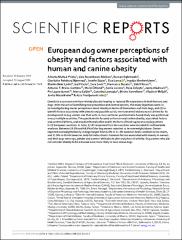European dog owner perceptions of obesity and factors associated with human and canine obesity

View/
Date
2018Author
Munoz-Prieto, Alberto
Rosenbaum-Nielsen, Liza
Dąbrowski, Roman
Reinhard-Bjornvad, Charlotte
Söder, Josefin
Lamy, Elsa
Monkeviciene, Ingrida
Beer Ljubić, Blanka
Vasiu, Iosif
Savić, Sara
Busato, Francesca
Yilmaz, Zeki
Bravo-Cantero, Antonio F.
Öhlund, Malin
Lucena, Sónia
Zelvyte, Rasa
Aladrović, Jasna
Lopez-Jornet, Pia
Caldin, Marco
Lavrador, Catarina
Karveliene, Birute
Mrljak, Vladimir
Mazeikiene, Jovita
Tvarijonaviciute, Asta
Metadata
Show full item recordAbstract
Obesity is a common nutrition-related disorder leading to reduced life expectancy in both humans and
dogs. With the aim of identifying new prevention and control options, the study objectives were (1)
to investigate dog-owner perceptions about obesity in terms of themselves and their dogs, and (2) to
identify factors associated with obesity and possible social, environmental and economic drivers for its
development in dog owners and their pets. A cross-sectional questionnaire-based study was performed
across multiple countries. The questionnaire focused on human and canine obesity, associated factors
and potential drivers, and was distributed online and in the form of hard copies among dog owners
in 11 European countries. In total, 3,185 responses from ten countries were included in multivariable
analyses. Between 19.1% and 48.8% of the dog owners reported to be overweight/obese. Ownerreported
overweight/obesity in dogs ranged from 6.0% to 31.3% based on body condition score charts,
and 31.8% to 69.4% based on body fat index charts. Common factors associated with obesity in owners
and their dogs were age, gender and owners’ attitudes to diet and physical activity. Dog owners who did
not consider obesity to be a disease were more likely to have obese dogs.
